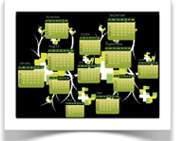Some people like to create their
email marketing when they feel inspired and send it all out within a few minutes of finishing. There's nothing wrong with that if that's how you work, but you should at least know that you can schedule your emails and that there is a knowledge base of scheduling best practices.
How Scheduling Works
As you create your email, you can choose what day and time you'd like to send it. You can also save it as a draft so that you can put off deciding when to send it until later on. If you've taken advantage of list segmentation, you can duplicate your email and send it to one list at a specific time and another part of your list later on.
Scheduling Best Practices
There are some things that are just plain common sense. You don't want to send email newsletters to business contacts on the weekends if you only have their office email address. But there are some tidbits of experience that can help even those who are the brightest:
Weekday Emails
Tuesday, Wednesday and Thursday are the best weekdays to deliver your
email campaigns. Monday is too busy as it starts the week, and Friday sometimes is not the most productive day because it starts the weekend.
Sunday Instead of Saturday
Saturday is just too deep in the weekend to be a prime emailing day. But recent studies have shown that not only is Sunday the best weekend day, it's actually one of the best days of the whole week on which to send out newsletters. More and more, people are using Sunday to check on email and shop online.
Send Often
We mentioned this before, but it is very applicable here. If you wait too long to send your first email or let too much time lapse between your newsletters, your previously eager list may just change their minds about your communications or might be not as responsive as they once were. They might totally forget that they subscribed to you and regard your out-of-the-blue email as
spam. Don't forget that they signed up for newsletter because they want information. This is why permission is so important: You only have people on your list who are anticipating information from you.
But Don't Send Too Often

The last thing you want to do is burn your list out. There's also the question of ROI – Return On Investment. Although email marketing is very inexpensive, there is some cost. If you send out too many emails and your response stagnates, you could be wasting money and time. Worse yet, you could be perceived as spamming, even though you have permission to send the person email.
And This Means What?
We think the average subscriber would enjoy a topical newsletter about once a week, definitely not more than three per week, probably more than once a month. Only you and your type of business can best determine this. But use common sense. A car buyer can only purchase so many cars in a month while a fast food restaurant's list might be responsive to daily specials. This is why campaigns matter: If you vary up your themes, topics and always provide fresh content, you'll never look like you're just sending out the same email week after week.